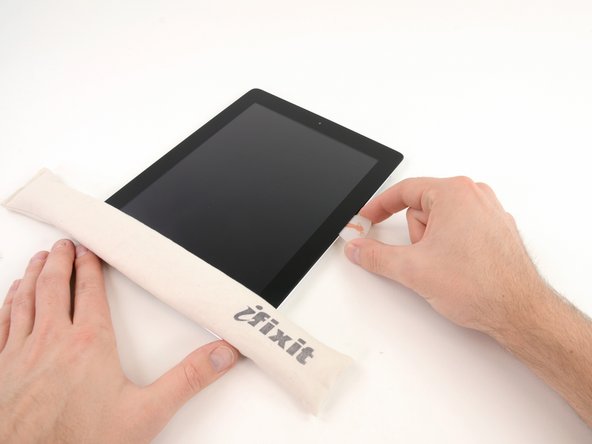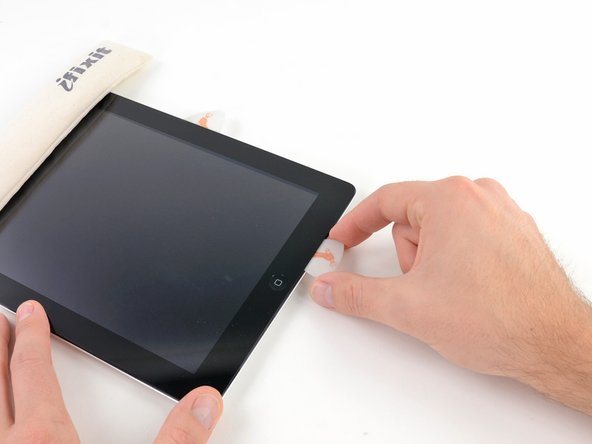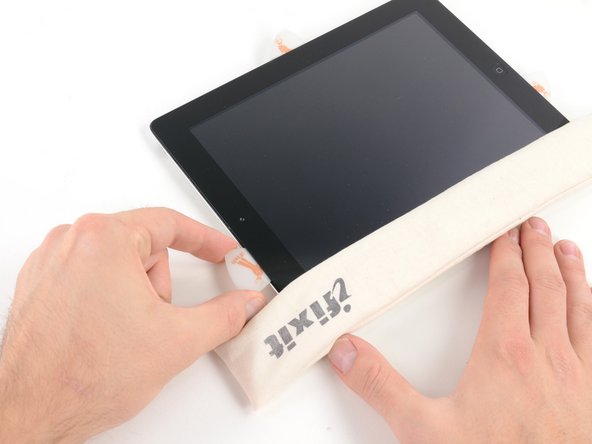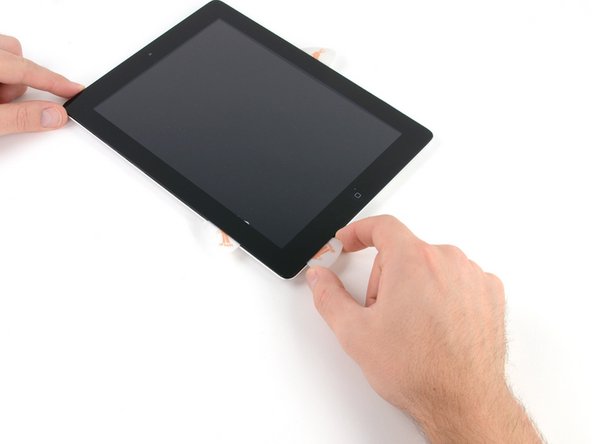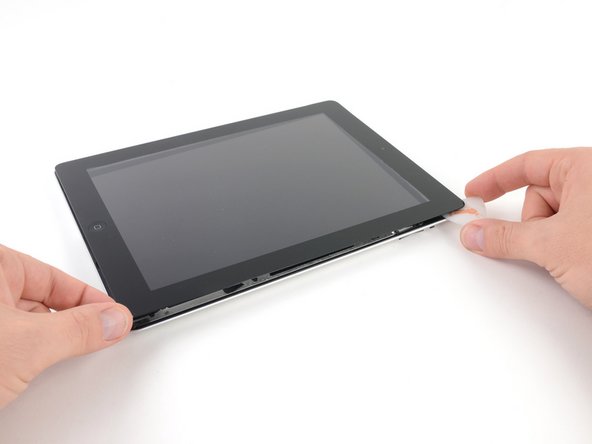iPad 2 GSM Right Cellular Data Antenna Replacement
Duration: 45 minutes
Steps: 66 Steps
Follow this guide to swap out the right cellular data antenna in your second generation iPad 2 GSM. Some parts of the guide feature the Wi-Fi version, so the inside might look a bit different, but don’t worry—the steps stay the same for both models unless we point out otherwise.
Step 1
For carousel microwaves: Ensure that the plate spins with ease. If your iOpener gets a bit stuck, it might just start to overheat and cause some trouble.
Hey there! Before diving in, it's a good idea to give your microwave a little TLC. A quick clean will ensure that any stubborn gunk on the bottom doesn’t hitch a ride on your iOpener. Let’s keep things tidy and smooth sailing!
- Pop the iOpener right in the middle of that microwave and let it soak up the warmth!
Tools Used
Step 2
Don't let the iOpener get too hot during your repair session. If it overheats, it might just explode on you. Keep it under 100˚C (212˚F) to stay safe.
If the iOpener looks like it's puffing up, it's time to step back. Give it space, and don't touch it.
If the iOpener is still too warm to handle in the middle, just give it a moment to cool down before you heat it up again. A well-heated iOpener will stay cozy for up to 10 minutes.
Your microwave's wattage can change the heating time, so keep an eye on it! The iOpener is ready to go when it’s just a tad too hot to handle.
- Pop the iOpener into the microwave for a solid 30 seconds to give it a nice warm-up.
- Keep the heat flowing! If the iOpener starts to cool down during the repair, just toss it back in the microwave for another 30 seconds to keep it at the perfect temperature.
Tools Used
Step 3
Heads up! The iOpener gets seriously hot, so handle with care. Don’t hesitate to grab an oven mitt if things start feeling toasty.
- Carefully take the iOpener out of the microwave, holding it by one of the two flat ends. Avoid grabbing the hot center — trust us, it's a lot hotter than it looks!
Tools Used
Step 4
Heads up! The iOpener gets super hot, so make sure to grab it only by the end tabs to keep your fingers safe.
No microwave? No problem! Just follow this step to warm up your iOpener in a pot of boiling water.
- Fill up a pot or pan with enough water to completely submerge your iOpener. We're talking fully immersed, no halfway dunking here!
- Turn up the heat and get that water boiling. Once it’s bubbling away, switch off the heat. Time to start the magic!
- Place your iOpener into the hot water and let it soak for 2-3 minutes. Make sure it's totally submerged. It’s like a spa day for your tool!
- Grab some tongs and carefully pull your iOpener out of the hot water. Don’t burn yourself – safety first!
- Dry your iOpener off with a towel. Make sure it’s completely dry before you go on your next adventure with it.
- All set! Your iOpener is now ready for action. If you need to reheat it, just boil the water again, turn off the heat, and let it soak for another 2-3 minutes. Easy peasy!
Tools Used
Step 5
- Grab a SIM eject tool or a trusty uncoiled paperclip and gently pop that SIM card tray out like a pro!
Step 6
- Gently slide the SIM tray out from its slot and take it out of the iPad 2.
- If you're swapping the SIM card, pop the old one out of the tray and drop the new one in.
Step 7
Don your safety glasses to give your peepers some love, and remember to be gentle with that LCD screen – we want it to shine bright!
This will help keep any pesky glass shards in check and maintain some solid structure while you're prying and lifting that display.
- If your display glass has seen better days and is cracked, let's keep it together and avoid any accidental injuries during your repair by adding some tape magic.
- Cover the entire face of your iPad with overlapping strips of clear packing tape—think of it as giving your device a cozy blanket for protection.
- Try your best to stick to the rest of the guide as outlined. Just a heads up, once the glass is shattered, it might keep cracking a bit more as you go along. You might even find yourself using a metal prying tool to gently scoop out the glass. If you run into any tricky spots, feel free to schedule a repair for some expert help!
Step 8
Just a heads up, working with broken glass can send tiny shards flying. So, grab some safety glasses to keep your eyes safe while you work—better safe than sorry!
- Place the iOpener flat along the right edge of the iPad. Make sure it’s snugly in place, creating solid contact between the iPad and the iOpener.
- Let the iOpener rest on the iPad for around 90 seconds. This gives it a little time to work its magic before you go ahead and open the front panel.
Tools Used
Step 9
You might need to put in a little muscle to slide that nifty opening tool's wedged tip between the glass and plastic. Take your time, stay chill, and give it a little wiggle back and forth as needed. You've got this!
- Check out the tiny gap in the iPad's adhesive ring at the upper right corner, about 2.0 inches (~5 cm) down from the top. This little spot is your ticket in.
- Line up your tool with the mute button. Gently slip the tip of a plastic opening tool into the crack between the front glass and plastic bezel—just the tip, enough to nudge the gap open a bit.
Step 10
- Make sure to position the tool just right—slip it gently between the plastic display bezel and the front panel glass. A little precision goes a long way!
Step 11
- Hold the tip of your trusty plastic opening tool snugly between the front glass and plastic bezel, then gently slide a plastic opening pick right alongside it into the gap.
Step 12
- Gently take out the plastic opening tool from the iPad, then slide the opening pick a little deeper under the front glass—aim for about half an inch in. Keep it smooth and steady!
Step 13
- As you gently tackle the adhesive on the right side of the iPad, give that iOpener a little reheat love and then cozy it up on the bottom edge of the iPad.
Tools Used
Step 14
The adhesive is super strong, so you might need to put in some elbow grease. Just take your time and be gentle with it!
If you can spot the tip of the opening pick peeking out from beneath the front glass, give it a gentle pull. While getting the pick this deep won’t cause any damage, it might leave a little adhesive residue on your LCD. Just a heads-up!
- As the iOpener warms up the bottom edge, start working on the right edge of your iPad to free that sticky adhesive. It's like peeling off a stubborn sticker!
- Carefully slide the opening pick down the edge of the iPad, releasing the adhesive as you go. Keep it steady and smooth for a clean separation!
Tools Used
Step 15
You might need to slide that warm iOpener back onto the right edge of the iPad while loosening the adhesive. How long the iPad has cooled off during your work will decide if this move is necessary.
- If your opening pick gets stuck in the adhesive, just roll it gently along the edge of the iPad to keep loosening that sticky stuff.
Tools Used
Step 16
- Before pulling out that first opening pick from the bottom corner of your iPad, slide in a second pick under the right edge of the front glass to keep that sticky adhesive from getting clingy again.
- Warm up the iOpener once more, then shift it over to the top edge of the iPad to keep things nice and toasty.
Tools Used
Step 17
Hey there! The Wi-Fi antenna is snugly fitted to the bottom right edge of the iPad's rear case with screws and a cable. Since the antenna's orientation is a bit tricky, let's take it slow and steady to avoid any mishaps that could lead to a permanent glitch in the Wi-Fi antenna. You've got this!
- Alright, folks, it's time to proceed with care! These next steps require a gentle touch.
- You'll need to carefully detach the adhesive that holds the antenna to the front panel. Just be sure to navigate around the delicate bits that connect the antenna to the bottom of the iPad. Take your time and follow these steps closely!
Step 18
Heads up! Don't push the pick past the bottom right corner or you might accidentally mess up the Wi-Fi antenna. Keep it chill and steady!
- Gently slide the opening pick around the bottom right corner of the iPad to loosen the adhesive holding it in place.
Step 19
Careful moving the opening pick along the bottom right edge of the front panel! The Wi-Fi antenna hangs out near the corner and can get cut if you’re not gentle with the adhesive.
Don’t yank the pick all the way out from under the front glass—just wiggle it back a bit so about 1/8" (3 mm) of the tip stays tucked under the glass.
- Gently glide the tip of the opening pick along the bottom edge of your iPad, freeing up that sticky adhesive over the Wi-Fi antenna like a pro.
Step 20
- After you pass the Wi-Fi antenna (about 3" or 75 mm from the right edge, right next to the home button), slide the opening pick all the way in.
- Gently glide the pick to the right to break the adhesive holding the Wi-Fi antenna to the front glass.
- The antenna is screwed and connected by a cable underneath the iPad. This step frees the antenna from the front panel so it stays safe when you take the panel off.
Step 21
Keep the iOpener's heating time to a max of one minute, and give it a cool two-minute break before you heat it up again. Safety first, and we want to keep things chill!
If the adhesive along the bottom edge has chilled out too much, give your iOpener another warm-up to soften it back up where you’re working.
- Keep sliding the opening pick along the bottom edge of the iPad, carefully pulling it out enough to get around the home button, then slide it back in about half an inch (10 mm) once you’ve cleared the button.
Tools Used
Step 22
Hey there! When you're working on iPad 4 models, remember to slide that pick in gently, but only up to about 1/2 inch (10 mm) in this spot. We want to keep that home button ribbon cable safe and sound!
- Keep peeling the adhesive along the entire bottom edge of your iPad with care.
- Slip the opening pick under the front glass near the home button and let it chill there.
Step 23
- Pop that iOpener into the microwave for a quick warm-up, then place it on the left edge of your iPad. This little buddy will help soften the adhesive in that spot, making your repair journey smoother.
Tools Used
Step 24
If your adhesive has gotten a bit too cool, just swap out the iOpener along that top edge and keep on going! And if the iOpener isn’t warm enough, give it a little reheat to get back in the game.
- Gently slide the opening pick along the top edge of the iPad, easing it out just enough to get around the front-facing camera bracket.
- Heads up: the adhesive here is super stubborn, so you might need to apply some firm pressure. Take it slow and steady to avoid any slips that could hurt you or your iPad.
- If the pick starts to feel stuck in the adhesive, try "rolling" it as shown in step 9 to keep things moving smoothly.
Tools Used
Step 25
If the adhesive is nice and toasty, feel free to take the iOpener off the iPad for some easy handling. But if it's still a bit too clingy, just reheat that iOpener and pop it back on the left edge while you work your magic.
- Keep peeling off that adhesive along the top edge of your iPad and gently work the opening pick around the top left corner. Almost there!
Tools Used
Step 26
The digitizer cable hangs out about 2" (50 mm) from the bottom of your iPad. Once you’re about 2.25" (60 mm) away from the bottom, it’s time to stop sliding that pick. You’re doing great!
- Gently glide that opening pick along the left edge of your iPad, letting it free the adhesive as you go along. The adhesive is a bit on the thinner side here thanks to the digitizer stretching out along that whole left side. Just a friendly reminder: keep the pick no deeper than 1/2 inch (10 mm) to avoid any mishaps with the digitizer. You've got this!
Step 27
Heads up! The bottom of the digitizer cable is just about an inch (25 mm) from the bottom of the iPad. Take it slow and steady—nobody wants a snipped cable!
- Grab that trusty opening pick that's still chilling under the iPad's bottom edge, and gently work it to break free the adhesive on the bottom left corner. Nice and easy!
Step 28
It looks like some of that adhesive around the edge of the iPad decided to play nice and stuck back down. No worries! Just slip a pick under the stubborn edge where the front glass is still hanging on tight, and gently ‘cut’ through that adhesive. You've got this!
- Grab one of your opening picks and gently pry up the bottom right corner of the iPad, then hold it securely with your fingers.
Step 29
Watch out for any stubborn adhesive still hanging on, and use an opening pick to carefully slice through any glue keeping the front panel stuck down.
- Grab your iPad by the top and bottom right corners, and give that front glass a gentle twist away from the device. You've got this!
- When it's time to put everything back together, make sure to use a microfiber cloth and some compressed air to dust off any specks or smudges on the LCD before placing the glass back on. A little clean-up makes a big difference!
Step 30
- Take out those four pesky 2.0 mm Phillips screws holding the LCD to the rear case tight! You've got this!
Step 31
- Gently lift the LCD from the edge closest to the volume buttons and swing it away from the rear case.
- Rest the LCD on the front panel just like you see in the second picture.
Step 32
Remember, you're gently prying up on the hinged retaining flaps, not the sockets themselves. Take it slow and steady!
Check out the red highlights in the second picture—they’re pointing to the retaining flaps you’ll want to keep an eye on.
- Gently use the edge of a plastic opening tool to lift up the retaining flaps on those two digitizer ribbon cable ZIF sockets. You've got this!
Step 33
- Grab your trusty plastic opening tool and gently slide it under the digitizer cable to lift it off the logic board shields. Easy does it!
- Now, with a careful touch, slowly peel the digitizer cable away from the adhesive that's keeping it snug against the rear case. You're doing great!
Step 34
- Gently pull the digitizer ribbon cable straight out from its two sockets on the logic board. You got this!
Step 35
When handling the LCD, take it easy and be careful. Don’t try to fully detach it from the iPad—its cable is still connected, so just rotate it gently over without forcing anything.
To get that front panel assembly off, you'll need to gently slide the ribbon cable out from between the case and the LCD. A little nudge of the LCD will create just enough space for this to happen.
- Carefully lift the LCD from its long edge farthest from the digitizer cable and gently fold it back toward the rear case—kind of like closing a book.
- While keeping the LCD lifted, smoothly slide the front panel away from the iPad. Watch out so the digitizer cable doesn’t catch on the rear case or LCD.
- Place the LCD back into the device body to keep it safe while you work.
Step 36
To dive into the iPad's inner workings, let's flip that LCD out of the case like a pro!
- Gently lift the LCD from the edge nearest the volume buttons and switch it out of the rear case—think of it as flipping a page in a book.
- Carefully place the LCD face down on a clean surface. A soft cloth underneath can help keep it scratch-free.
Step 37
Be gentle when disconnecting the connector—pulling it straight up could cause a ruckus.
- Gently place the LCD next to the back panel without rushing.
- Grab a plastic opening tool and carefully flip the display data cable lock upward.
- Slowly pull the display data cable out from its socket like a pro.
Step 38
- Gently detach the LCD assembly from the rear panel assembly. You've got this!
Step 39
Make sure to pry upward on the hinged retaining flap itself, not on the socket—play it smart and gentle!
- Grab a plastic opening tool and gently lift the retaining flap on the headphone jack and front camera cable ZIF socket. You’ve got this!
- Carefully peel away the headphone jack and front camera cable from the rear case. Easy does it!
Step 40
- Gently pull the headphone jack and front camera ribbon cable straight out from their sockets on the logic board.
Step 41
- Unscrew the three tiny 2 mm Phillips screws that are holding the SIM card slot in place on the back panel. You got this!
Step 42
- Unscrew the two 2.9 mm Phillips screws holding the headphone jack to the top edge of the rear panel. Keep these screws safe—they're the VIPs of this step!
Step 43
Hold up! Don’t yank the assembly out just yet—the ribbon cables are still hanging on.
- Grab a trusty plastic opening tool and gently pry the headphone jack out from its cozy little spot at the top of the rear panel. You've got this!
Step 44
- Carefully detach the front camera and microphone cables from the rear panel.
Step 45
- Gently peel away the tape that’s cozying up to the front camera cable connector. We want that little guy to breathe!
- Grab your trusty plastic opening tool and give a gentle nudge to disconnect the front camera cable from its buddy, the microphone cable, hanging out right below it.
Step 46
- Gently peel the front camera cable away from the microphone cable.
Step 47
Watch out for those delicate camera, microphone, and headphone jack ribbon cables while you're peeling off that tape! Treat them like the precious little gems they are!
- Peel off that piece of tape marked in red like it's a sticker on your favorite fruit. You've got this!
Step 48
- Carefully detach the front camera from the foam adhesive that's holding it snugly against the rear panel.
Step 49
- Gently pull the front-facing camera cable out from the groove carved into the back panel.
- Carefully lift the front-facing camera away from your iPad.
Step 50
- Grab a plastic opening tool and gently pop off the microphone cable connector.
- Carefully take out the headphone jack and SIM slot from the device.
Step 51
- If you spot any tape covering the end of the dock connector cable, gently peel it off.
- Grab a plastic opening tool and carefully lift the dock connector cable's connector out of its socket on the logic board—slow and steady wins the race!
- Peel the dock connector ribbon cable away from the rear panel with a smooth motion.
Step 52
- Slide your prying tool under the 4 wires at the end of the connector and carefully lift the speaker cable connector straight up from its spot on the logic board. Avoid prying from the other end, as that could snap the 4 solder points underneath the socket, leading to a tricky microsolder fix.
Step 53
Avoid pulling the cable straight up when disconnecting it—it’s not a magic trick!
- Grab your trusty plastic opening tool and give that retainer a little nudge to lift it up. It's holding the upper component board cable connector snugly in place, and we need to free it so it can party with the logic board.
- Now, gently pull the connector away from its socket on the logic board. You're doing great—keep going!
Step 54
- Unscrew the two 2.1 mm Phillips screws holding the logic board bracket to the rear case right by the digitizer cable socket. Keep track of those little guys!
- Lift the logic board bracket off the rear case and set it aside safely.
Step 55
- Take out those four 2.6 mm Phillips screws that are keeping the logic and communications boards snug against the rear panel. You've got this!
Step 56
- Grab a plastic opening tool and carefully lift the logic board away from the rear case. You've got this!
- The logic board is stuck to the rear case with some adhesive magic; take your time and peel it off gently to avoid any mishaps. You're doing great!
Step 57
Heads up! Don’t try to yank out the logic board just yet—there are still three antenna cables holding on tight.
- Gently lift the logic board out of the rear case and give it a little twist towards the battery, like you're turning the page of a good book.
Step 58
- Grab your trusty plastic opening tool and gently pop the cellular data antenna cable out of its cozy little home on the communications board. You're doing great—keep it up!
Step 59
- Take out the single 2.1 mm Phillips screw that’s keeping the cellular data antenna cable cozy with the rear case. Time to set it free!
Step 60
Time to peel off the two tape strips holding the cellular data antenna cable snug against the rear case—careful does it!
- Grab your trusty spudger and gently nudge those two pesky pieces of tape away. You've got this!
Tools Used
Step 61
- Carefully pop the cellular data antenna loose from the back case using a plastic opening tool—easy does it!
Step 62
- Carefully lift the cellular data antenna from its cozy spot in the iPad casing.
- Gently guide the cellular data antenna cable through the little channel carved into the rear panel, and then free the antenna from the device.
Step 63
- Grab a plastic opening tool and gently unplug the right antenna cable from its spot on the communications board. Easy does it!
Step 64
- Unscrew the lone 2.1 mm Phillips screw holding the right cellular antenna to the back case. You got this!
Step 65
Time to get your hands a little sticky! Carefully peel off those three pieces of tape holding the right cell antenna cable to the rear case. You've got this!
- Start by gently nudging each piece with the spudger’s tip, then switch to the flat end to carefully lift the tape like a pro—no tears allowed!
Tools Used
Step 66
- Carefully slide a plastic opening tool under the antenna to pop it away from the rear case without any oops moments.
- Lift the right cellular data antenna out of the iPad 2 and set it aside like a pro.




























